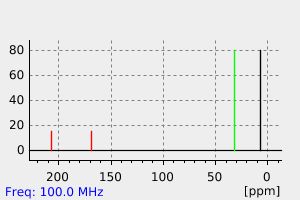2-oxobutanoate | 339-71-9
中文名称
——
中文别名
——
英文名称
2-oxobutanoate
英文别名
2-oxobutyrate;α-ketobutyrate;2-keto-butyrate
CAS
339-71-9
化学式
C4H5O3
mdl
——
分子量
101.082
InChiKey
TYEYBOSBBBHJIV-UHFFFAOYSA-M
BEILSTEIN
——
EINECS
——
-
物化性质
-
计算性质
-
ADMET
-
安全信息
-
SDS
-
制备方法与用途
-
上下游信息
-
文献信息
-
表征谱图
-
同类化合物
-
相关功能分类
-
相关结构分类
计算性质
-
辛醇/水分配系数(LogP):0.8
-
重原子数:7
-
可旋转键数:1
-
环数:0.0
-
sp3杂化的碳原子比例:0.5
-
拓扑面积:57.2
-
氢给体数:0
-
氢受体数:3
反应信息
-
作为反应物:描述:2-oxobutanoate 在 1,6-di-o-phosphonohex-2-ulofuranose 、 piperazine*HCl buffer 、 还原型辅酶Ⅰ 作用下, 生成 DL-2-羟基丁酸参考文献:名称:Gln102Arg和Cys97Gly突变对嗜热脂肪芽孢杆菌L-乳酸脱氢酶结构特异性和立体特异性的影响摘要:嗜热脂肪芽孢杆菌 (BSLDH) 的 L-乳酸脱氢酶是一种热稳定酶,在不对称合成中具有相当大的应用潜力。因此,了解控制其结构特异性和立体特异性的因素是很有意义的。本文评估了 GIn 102→Arg 和 Cys97→Gly 突变的影响。在对 13 种 2-酮酸的调查中,发现 Q102R 突变降低了 BSLDH 还原具有小或亲水 R 基团的 RCOCOOH 底物的活性,而不影响其对具有较大疏水性 R 取代基的那些的活性DOI:10.1021/ja00038a016
-
作为产物:参考文献:名称:蛋氨酸γ-裂合酶(MGL)催化的连续分光光度法测定和非线性动力学分析。摘要:在本文中,我们提出了一种新的,易于实施的测定方法,用于MGL催化的L-甲硫氨酸及其类似物生成α-酮丁酸(α-KB)产物的γ消除反应。该测定采用紫外可见分光光度法,通过在315 nm处的吸光度连续监测α-KB的形成速率。我们还采用了一种非线性数据分析方法,该方法避免了“初始斜率”确定的需要,该方法会在进度曲线为非线性时引入误差。通过1H NMR产物分析对分光光度法进行了验证,结果表明,在研究条件下,L-蛋氨酸和L-蛋氨酸砜的底物可转化为α-KB产物,收率大于99%。使用这种测定方法,我们首次确定了牙龈卟啉单胞菌的MGL重组形式的Michaelis-Menten参数,得出L-met的kcat和Km值为328 +/- 8 min-1和1.2 +/- 0.1 mM。 γ消除,对于L-met砜γ消除反应为2048 +/- 59 min-1和38 +/- 2 mM。我们设想,该测定方法对于确定产生α-DOI:10.1016/j.ab.2016.05.010
-
作为试剂:描述:2-AMINO-4-METHOXY-N-METHYL-5-OXAZOL-5-YL-benzamide 在 对甲苯磺酸一水合物 MgSO4 、 2-oxobutanoate 作用下, 以 二氯甲烷 、 丙酮 、 甲苯 为溶剂, 以22%的产率得到7-Methoxy-3-methyl-6-oxazol-5-yl-4-oxo-1,2,3,4-TETRAHYDRO-QUINAZOLINE-2-CARBOXYLIC acid ethyl ester参考文献:名称:[EN] QUINAZOLINONE DERIVATIVES
[FR] DERIVES DE QUINAZOLINONE摘要:翻译结果如下: 公式(1)的化合物:其中:X是氧原子或硫原子;R1是脂肪族、环脂肪族或环烷基-烷基团;R2是可选地取代的杂芳基团或-CN基团;R3是组-(Alk1)mL1(Alk2)nR6,其中m和n相同或不同,都是零或整数1,Alk1和Alk2相同或不同,都是可选地取代的脂肪族或杂脂肪族链,L1是共价键或连接原子或团,R6是氢原子或可选地取代的环脂肪族、杂环脂肪族、芳香族或杂芳族团;R4是组-(Alk3)pL2(Alk4)qR7,其中p和q相同或不同,都是零或整数1,Alk3和Alk4相同或不同,都是可选地取代的脂肪族或杂脂肪族链,L2是共价键或连接原子或团,R7是氢或卤素原子或-CN基团或可选地取代的环脂肪族、杂环脂肪族、芳香族或杂芳族团;R5是氢原子或可选地取代的脂肪族团;以及其盐、溶剂化物、水合物、互变异构体、同分异构体或N-氧化物。本发明的化合物是IMPDH的强效抑制剂。公开号:WO2004018462A1
文献信息
-
Biocatalytic Construction of Quaternary Centers by Aldol Addition of 3,3-Disubstituted 2-Oxoacid Derivatives to Aldehydes作者:Roser Marín-Valls、Karel Hernández、Michael Bolte、Teodor Parella、Jesús Joglar、Jordi Bujons、Pere ClapésDOI:10.1021/jacs.0c09994日期:2020.11.183-methyl-2-oxobutanoate hydroxymethyltransferase from E. coli (KPHMT) and variants thereof. The 3,3,3-trisubstituted 2-oxoacids thus produced were converted into 2-oxolactones and 3-hydroxy acids and directly to ulosonic acid derivatives, all bearing gem-dialkyl, gem-cycloalkyl, and spirocyclic quaternary centers. In addition, some of these reactions use a single enantiomer from racemic nucleophiles to afford
-
Donor Promiscuity of a Thermostable Transketolase by Directed Evolution: Efficient Complementation of 1-Deoxy-<scp>d</scp> -xylulose-5-phosphate Synthase Activity作者:Thangavelu Saravanan、Sebastian Junker、Michael Kickstein、Sascha Hein、Marie-Kristin Link、Jan Ranglack、Samantha Witt、Marion Lorillière、Laurence Hecquet、Wolf-Dieter FessnerDOI:10.1002/anie.201701169日期:2017.5.2Enzymes catalyzing asymmetric carboligation reactions typically show very high substrate specificity for their nucleophilic donor substrate components. Structure‐guided engineering of the thermostable transketolase from Geobacillus stearothermophilus by directed in vitro evolution yielded new enzyme variants that are able to utilize pyruvate and higher aliphatic homologues as nucleophilic components
-
Chemoselective detection and discrimination of carbonyl-containing compounds in metabolite mixtures by <sup>1</sup> H-detected <sup>15</sup> N nuclear magnetic resonance作者:Andrew N. Lane、Sengodagounder Arumugam、Pawel K. Lorkiewicz、Richard M. Higashi、Sébastien Laulhé、Michael H. Nantz、Hunter N.B. Moseley、Teresa W.-M. FanDOI:10.1002/mrc.4199日期:2015.5NMR spectra of mixtures of metabolites extracted from cells or tissues are extremely complex, reflecting the large number of compounds that are present over a wide range of concentrations. Although multidimensional NMR can greatly improve resolution as well as improve reliability of compound assignments, lower abundance metabolites often remain hidden. We have developed a carbonyl‐selective aminooxy从细胞或组织中提取的代谢物混合物的 NMR 谱极其复杂,反映了存在于广泛浓度范围内的大量化合物。尽管多维 NMR 可以极大地提高分辨率并提高化合物归属的可靠性,但丰度较低的代谢物通常仍处于隐藏状态。我们开发了一种羰基选择性氨氧基探针,它与游离的酮和醛官能团发生特异性反应,但不与羧酸盐发生反应。通过在氨基氧基官能团中加入 15N,使用 15N 编辑的 NMR 专门选择那些含有游离羰基官能团的代谢物,而排除所有其他代谢物。在这里,我们证明酮和醛的氨氧基加合物的化学位移非常不同,例如,它可用于区分醛糖和酮糖。利用 2 键或 3 键 15N-1H 偶联,首先使用真实标准对 15N 编辑的 NMR 分析进行优化,然后应用于肺腺癌细胞系 A549 的提取物。超过 30 种 NMR 可检测水平的含羰基化合物,其中 6 种是我们参考我们的数据库指定的。
-
Structural Determinants for the Non-Canonical Substrate Specificity of the ω-Transaminase from<i>Paracoccus denitrificans</i>作者:Eul-Soo Park、Sae-Rom Park、Sang-Woo Han、Joo-Young Dong、Jong-Shik ShinDOI:10.1002/adsc.201300786日期:2014.1.13limited synthetic applications of ω‐TA to access structurally diverse chiral amines and amino acids. Here we report the first example of an ω‐TA whose S pocket shows a non‐canonical steric constraint and readily accommodates up to an n‐butyl substituent. The relaxed substrate specificity of the (S)‐selective ω‐TA, cloned from Paracoccus denitrificans (PDTA), afforded efficient asymmetric syntheses ofω-转氨酶(ω-TA)的底物结合口袋由能够双重识别疏水和羧基取代基的大(L)口袋和一个表现出严格的空间限制而不允许取代基进入的小(S)口袋组成比乙基。尽管ω-TA具有独特的催化作用,可实现羰基化合物的不对称还原胺化,但S口袋中发生的严重尺寸排阻限制了ω-TA的合成应用,从而难以获得结构多样的手性胺和氨基酸。在这里,我们报告一个ω-TA的第一个例子,它的S口袋显示出非规范的空间约束,并且很容易容纳多达一个正丁基取代基。(S)选择性ω-TA的宽松底物特异性,克隆自反硝化副球菌(PDTA)可有效地合成带有长烷基侧链的非天然氨基酸的非对称氨基酸,例如L-缬氨酸和L-正亮氨酸。使用最近发布的PDTA的X射线结构进行分子建模可以查明仍然令人怀疑的S口袋的确切位置。发现疏水取代基进入L口袋使S口袋接受至多乙基取代基,让人联想到典型的空间位阻。相反,羧基与L口袋的结合导致V153略微远离形成小口袋的残基。
-
Valine 375 and Phenylalanine 109 Confer Affinity and Specificity for Pyruvate as Donor Substrate in Acetohydroxy Acid Synthase Isozyme II from <i>Escherichia coli</i>作者:Andrea Steinmetz、Maria Vyazmensky、Danilo Meyer、Ze′ev Barak、Ralph Golbik、David M. Chipman、Kai TittmannDOI:10.1021/bi100555q日期:2010.6.29result from a stronger hydrophobic interaction of the ethyl substituent of 2-KB with the side chain of Trp464 in multiple, apparently committed steps of catalysis. Here, we have elucidated the molecular determinants conferring specificity for pyruvate as the sole physiological donor substrate. Structural studies and sequence alignments of the POX subfamily of ThDP enzymes that act on pyruvate indicate乙酰羟酸合酶(AHAS)是一种硫胺素依赖性磷酸酶,可催化丙酮酸与另一个丙酮酸分子(乙酰乙酸产物)或2-酮丁酸(乙酰羟丁酸产物)的缩合反应,这是生物合成支链氨基酸的第一步。在植物,细菌,藻类和真菌中。大肠杆菌的AHAS同工酶II相对于丙酮酸作为受体,对2-酮丁酸酯(2-KB)的特异性高60倍,这表明是由于2-KB的乙基取代基与Trp464的侧链在多个表面上的较强疏水相互作用所致催化步骤。在这里,我们阐明了赋予丙酮酸作为唯一的生理供体底物的特异性的分子决定簇。对丙酮酸起作用的ThDP酶POX亚家族的结构研究和序列比对表明,缬氨酸和苯丙氨酸与丙酮酸的甲基取代基疏水相互作用。进行了在这些位置(Val375Ala,Val375Ile和Phe109Met)处有取代的AHAS同工酶II变体的动力学和热力学研究。Val375变体的k值略有降低猫与表观的适度增加ķ中号丙酮酸,两者的底物亲和力和ķ猫在AHAS
表征谱图
-
氢谱1HNMR
-
质谱MS
-
碳谱13CNMR
-
红外IR
-
拉曼Raman
-
峰位数据
-
峰位匹配
-
表征信息
同类化合物
马来酰基乙酸
顺-3-己烯-1-丙酮酸
青霉酸
钠氟草酰乙酸二乙酯
醚化物
酮霉素
辛酸,2,4-二羰基-,乙基酯
草酸乙酯钠盐
草酰乙酸二乙酯钠盐
草酰乙酸二乙酯
草酰乙酸
草酰丙酸二乙酯
苯乙酰丙二酸二乙酯
苯丁酸,b-羰基-,2-丙烯基酯
聚氧化乙烯
羟基-(3-羟基-2,3-二氧代丙基)-氧代鏻
磷酸二氢2-{(E)-2-[4-(二乙胺基)-2-甲基苯基]乙烯基}-1,3,3-三甲基-3H-吲哚正离子
碘化镝
硬脂酰乙酸乙酯
甲氧基乙酸乙酯
甲氧基乙酰乙酸酯
甲基氧代琥珀酸二甲盐
甲基4-环己基-3-氧代丁酸酯
甲基4-氯-3-氧代戊酸酯
甲基4-氧代癸酸酯
甲基4-氧代月桂酸酯
甲基4-(甲氧基-甲基磷酰)-2,2,4-三甲基-3-氧代戊酸酯
甲基3-羰基-2-丙酰戊酸酯
甲基3-氧代十五烷酸酯
甲基2-氟-3-氧戊酯
甲基2-氟-3-氧代己酸酯
甲基2-氟-3-氧代丁酸酯
甲基2-乙酰基环丙烷羧酸酯
甲基2-乙酰基-4-甲基-4-戊烯酸酯
甲基2-乙酰基-2-丙-2-烯基戊-4-烯酸酯
甲基2,5-二氟-3-氧代戊酸酯
甲基2,4-二氟-3-氧代戊酸酯
甲基2,4-二氟-3-氧代丁酸酯
甲基1-异丁酰基环戊烷羧酸酯
甲基1-乙酰基环戊烷羧酸酯
甲基1-乙酰基环丙烷羧酸酯
甲基1-乙酰基-2-乙基环丙烷羧酸酯
甲基(2Z,4E,6E)-2-乙酰基-7-(二甲基氨基)-2,4,6-庚三烯酸酯
甲基(2S)-2-甲基-4-氧代戊酸酯
甲基(1S,2R)-2-乙酰基环丙烷羧酸酯
甲基(1R,2R)-2-乙酰基环丙烷羧酸酯
瑞舒伐他汀杂质
瑞舒伐他汀杂质
环氧乙烷基甲基乙酰乙酸酯
环戊戊烯酸,Β-氧代,乙酯







